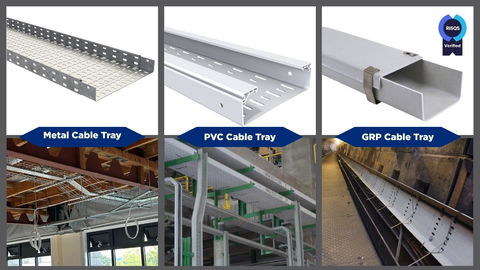By Terry Adams, Technical Services Manager at Marshall-Tufflex: When it comes to cable containment on-site, using the right tray for the right job can save time, boost safety, and ensure long-term performance. With so many cable tray options on the market - metal, PVC-U, GRP - knowing what to choose and where to use it is key.

Whether you’re working on a fast-paced commercial build, a demanding industrial site, or a high-spec data centre, here’s what you need to know to make sure your cable tray installation is safe, compliant, and built to last.
Start With the Right Material
The environment and application should drive your material choice:
Pre-galvanised Steel Cable Tray – The go-to for most internal commercial installs. It’s strong, available in light to heavy-duty gauges, and straightforward to install. Look for ranges that bolt together without the need for couplers to speed things up on-site.
PVC Cable Tray – Ideal for corrosive or high-humidity environments where metal would degrade. Think water treatment plants or food processing areas. Lightweight and easy to handle, PVC tray is non-corrosive and a smart alternative in the right setting.
GRP (Glass Reinforced Polyester) – If you're installing in harsh environments - outdoors, near chemicals, or in marine and industrial applications - GRP is the answer. It’s corrosion and UV resistant, handles extreme temperatures, and is LS0H (low smoke zero halogen). Despite being incredibly tough, it’s lighter than steel and aluminium, making it easier to lift, cut, and fix.
If you're working on transport infrastructure (rail, for example), check if your supplier is RISQS verified - a key compliance box for public sector and large-scale projects.
Loading Capacities Matter
Don’t overload your tray - doing so risks collapse, non-compliance, or worse.
Before installation, calculate:
Cable weight and quantity (based on cable spec sheets)
Tray loading capacity (supplied by the manufacturer)
Tray self-weight (important for overall load on supports)
If there’s a chance the system will expand later, go for a tray with a higher loading spec now. It saves hassle and cost down the line.
Fire Safety: Get It Right First Time
Cable trays play a critical role in fire safety. If containment fails in a fire, falling cables can trap people or prevent escape. The 18th Edition Wiring Regulations (Reg 521.10.202) require all cables to be properly supported using non-combustible fixings—not just those in escape routes.
Steel trays automatically meet this requirement as they can withstand extreme heat (1200–1500°C melting point). If you’re using PVC-U or aluminium, you'll need additional fire-resistant fixings secured directly to the building structure. BEAMA’s guide on premature collapse offers clear advice on this so check it out during install.
Fit for Purpose = Fully Compliant
It’s the contractors responsibility to ensure everything is fit for purpose and compliant with the IET Wiring Regulations. Make sure your install:
Uses the right tray material for the conditions
Has been checked for loading capacity
Meets fire resistance standards
Is easy to access for future maintenance or upgrades
Need a tray system that covers all bases?
Marshall-Tufflex offer a complete range of metal, PVC-U, and GRP cable trays and accessories - everything from bends and tees to lids and risers.
